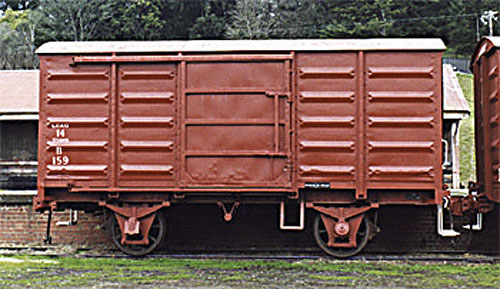B159 - Four Wheel Box Van

History of the class
By the late 1950's it was thought that additional small box cars (as opposed to ventilated louvre vans – e.g. “U” vans) were required to replace both older vehicles and to provide for future railway traffic. At the time many older open 4-wheeled “I” and “IA” wagons and “U” louvre vans were being scrapped.
Thus it was planned to build 500 (4 wheeled – 14 ton capacity) steel box cars onto both scrapped and/or new underframes. The bodies of the box cars were of a style similar to the medium size bogie box vans coded “BB” and “BP” that had recently been built. The planned construction of “B” vans was later reduced to 400. The order was actually stopped at 350 built but with extra components still left unused, a further 30 vans were constructed taking the total class to 380 vehicles.
The prototype van B 1 was built at the North Melbourne wagon workshops, entering service on December 10th 1957. It was unique in that it merely had plain, sheet-steel ends without the strengthening pressings. It seems the rest of the class (379 wagons) were built at Bendigo North Workshops between September 19th, 1958 and June 6th 1961 from both second-hand underframes from vehicles constructed between 1909 and 1921 (about 1/3 of the fleet) and the remainder on newly constructed underframes (about 2/3 of the fleet).
The three “B” box vans in the DSCR collection are all interesting in they were in the 1/3 of the fleet built on underframes with “past lives”.
History of B159
This box car began life in 1911 also as an “I” open truck, “I 9837”; known as a “Shandie” (see history for “B 91” above). She was either built at A. Challingsworth in Burnley or by Cowley Pty Ltd, Ballarat.
In August 1930 she was returned to the Workshops where she was fully rebuilt in steel again as a 16 ton capacity truck. Seemingly “I 9837” remained a true “I” truck for the rest of her operating life and was never reclassified “IA”.
“I 9837” went to North Bendigo Workshops on August 19, 1959 to be converted to a “B” box van. The vehicle “I 9837” was officially scrapped on February 10, 1958.
As “B 159” the box car only saw 20 years’ service before being placed Off Register (scrapped) on May 7, 1979. The little “B” van survived the scrapper’s torch and arrived at the Central Highlands Tourist Railway (DSCR) around 1990. B159 is currently used for storage and not operational. It is painted for circa 1969 period.
Additional Info
By the early 1980's, most “B” vans were rapidly being scrapped with some diverted into use as Departmental vehicles for the Way and Works and other Branches. In this guise some vans retained the classification “B” whereas most were reclassified “HD”.
The reason for the name of the “HD” vehicles is really interesting. Their classification has its heritage in the box vans acquired from the private Deniliquin & Moama Railway takeover by the Victorian Railways in 1923. This railway was built entirely in New South Wales but only connected to the Victorian Railways system at Echuca. It was planned as an “add-on” the original, private “Melbourne, Mount Alexander and Murray River Railway” (Southern Cross – Bendigo – Echuca), which went broke during early stages of construction and led to the formation of the Victorian (Government) Railways Department to complete the Railway.
At some point these purely “number only” D&MR wagons were assigned the coding “HD”, the “H” adopted from the official (then - old coding) VR wagon coding alphabet for “box wagon” and the “D” to denote the private origins of the wagon from the D&MR. This coding system was applied to the vehicles prior to the 1920's to assist in rolling stock identification when these private wagons ventured onto Victorian Government railway lines. Prior to this, “HD” coding the D&M stock was unclassed. The numbers of the HD vans were merely D&M Railway wagon numbers 5 to 31.
After the VR takeover and as these box vans had been built in the late 1870's, they were deemed unsuitable for freight traffic and were placed into service as railway 'plant'/service trucks. As previously outlined, these vans were used for storing workmens’ materials. These 1870’s Deniliquin and Moama Railway box vans began to be scrapped up to as late as the 1950’s. Their replacements were vehicles like the 1959/1960 VR built “B” 4-wheeled box vans which were modified for the same service stock use.
The “B” vans were the last modern 4-wheeled box cars ever built by the Victorian Railways. They transported non-perishable “less-than-car-load” small freight consignments to the dying branch lines of the once mighty VR. When the next/last large “batch” of Victorian branch lines were rapidly closed over 1976 - 1978 period, these not very old vehicles no longer had a role.
Prepared by Sean Kelly with thanks to rolling stock historian Peter J. Vincent and the late Frank Kelly.


